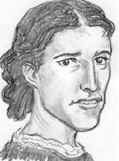Charlotte Perkins Gilman

Charlotte Perkins Gilman, critic, novelist and poet, was born Charlotte Anna Perkins on this day in 1860 in Hartford, Connecticut. The great-granddaughter of theologian Lyman Beecher and the great-niece of Harriet Beecher Stowe and Henry Ward Beecher, Charlotte Perkins' father left her mother shortly after Charlotte's birth. After a spotty education, culminating with a stint at the Rhode Island School of Design, she earned a living by designing greeting cards and, less happily, teaching children; in her spare time, however, she was a voracious reader, particularly of Social Darwinist tracts.
Against her better judgment she married artist Charles Stetson in 1884, gave birth to a daughter, and quickly sank into a deep depression. Her consulting neurologist, S. Weir Mitchell, prescribed a "rest cure," forbidding her ever to write again and limiting her reading severely. Horrified, Charlotte fled to California, where she turned to writing and lecturing as her career. She eventually divorced Stetson, who married her best friend Grace Ellery Channing.
Fueled by her readings of such commentators as Lester Ward, in countless articles and lectures (and even in poems) Charlotte Perkins began to articulate a critique of gender relations, proceeding from Ward's assumption that humans are set apart from other animals in that they are able to determine their own laws of social behavior. Perkins' further observation was that human volition had been twisted over time; women were denied autonomy, and thus their ability to define social relations had atrophied, whereas men's personalities were distorted by lazy habits learned from having uninterrupted dominance over women. The goal of a reorganized society, she asserted, would be to transform the prevailing "masculinism" into a humane social order, equally informed by nurturing and collaborative female values.
Perkins' breakthrough work, Women and Economics (1898), was a sensation; in it, Perkins declared that the sex relationship is an economic relationship. In that both men and women are essentially defined by the way they make their living, she argued, the lack of occupational autonomy suffered by women meant that they were almost completely in the service of the men who take care of them, creating the underpinnings of all gender-based social imbalance. Her subsequent social critiques developed the theme in other contexts: Concerning Children, 1900; The Home: Its Work and Influence, 1903; The Man-Made World, or Our Androcentric Culture, 1911; His Religion and Hers, 1923. While such works were influential among later academic feminists, she is perhaps better known today for her fiction, especially the short story "The Yellow Wallpaper" (1892, based on her experience with Mitchell's "rest cure") and Herland (1915, describing a world of women only).
In 1900, having established herself as a leading feminist critic, she married her cousin George Gilman and lived relatively happily until his death in 1934. Shortly thereafter, Perkins, who was suffering from inoperable breast cancer, took her own life on August 17, 1935 in Pasadena, California, leaving behind a note in which she explained: "When all usefulness is over, when one is assured of unavoidable and imminent death, it is the simplest of human rights to choose a quick and easy death in place of a slow and horrible one."
Labels: Literature, Philosophy, Trailblazing Women





0 Comments:
Post a Comment
Subscribe to Post Comments [Atom]
<< Home